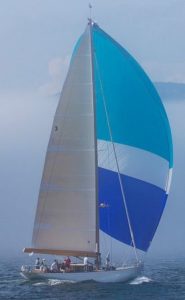
Our new, modern-classic “Anna” racing into the fog, Photo: Daniel Forster
Camden Classics Cup, July 26-28:
It was a good few days for traditional and modern sailboat racing in Penobscot Bay, Maine. The third running of the Camden Classics Cup continued to build on the success of the first two events. We counted 68 yachts on the scratch sheet.
Or about double the 30 boats that shaped up to race, year before last.
We’re shameless promoters of the Camden Classics. We are sponsors of the regatta. We serve on committees to improve the rules for it. And our boats, and our selves, race in the event. And even discounting for all that, we can say that any sailor would have to admit this year’s fleet featured lovely boats, big and small, and robust competition across all classes in some of the most breathtaking scenery on earth.
What we like best about the “Camden Classics” is its emphasis on inclusivity. The event’s organizers understand that owning a classic vessel isn’t for everyone — but sailing next to one is. Accordingly, this regatta is cleverly designed to offer level competition for mainstream vessels, that also shares the racecourse with spectacular vintage and classic boats. So, unlike most regattas that feature modern one-design and production boats, the Camden Classics is organized to make it easy for old and new designs to compete together successfully. No boats are excluded based on aesthetic or technological considerations. More is more with the Camden Classic Cup.
This year, the Camden Classics experimented with a Daysailer class. And up until a couple of weeks before race day, there were just two boats on the scratch sheet. But by the starting gun, the little guys showed up big time: There were more than a dozen late sign-ups, featuring some excellent Dark Harbor 17’s, Buzzards Bay 18’s, and the venerable Dolphin class, which held its Dolphin Worlds at this event. The Dolphin fleet has been a big supporter of the Camden Classics from Day One. Thanks, to you all.
Over all, skipper response was excellent. Apparently, the shorter courses made racing for these miniatures more fun. But handicapping and organizing these smaller boats turned out to be just as complex as big boats. The late turnout meant some boat data was incomplete. And it wasn’t clear if the Classic Yacht Racing Formula, the handicap rule used, would fairly organize the fleet. That made this year’s race more of a trial and error event. Skippers and organizers learned a lot. Organizers will require rating certificates earlier next year, and work with owners more closely to properly organize racing.
Regardless, the growing Daysailers class was a big success at the Camden Classics.
Classing the Camden Classic.
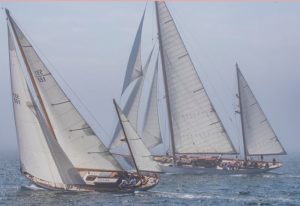
The turnout was deep enough for both a Vintage and a Classic classes. Photo: Daniel Forster
The excellent turnout meant that the Vintage and Classic classes attracted enough boats to warrant splitting each into two subgroups. Larger boats raced longer courses than smaller boats, resulting in closely spaced finishes and easy arrival back in the harbor, all in good time to clean up and attend post-race events.
But there was still controversy: The Race Committee included the 12-meter Valiant in the Classic class. And for a good reason: The Camden Classic Cup is different in its approach to classing. The grouping is organized by design date, rather than on design features and construction materials. Valiant was drawn in 1970, placing her solidly in that Classic pedigree. But, her separate keel and rudder is unusual to the Classic rubric. In other regattas, Valiant would probably be dissed off into a Spirit-of-Tradition division. But the Camden Classics Cup has clear definitions for class divisions, with a priority set on design date. The Spirit-of-Tradition fleet is only for yachts that have been purpose-designed to capture traditional aesthetics in a modern performance package. That is not Valiant’s design mission.
We understand that a black-and-white grouping based strictly on design year will likely place some boats in a sort of class purgatory between Classic and Spirit-of-Tradition divisions. Take the split underbodies of a 1970’s 12-meter racer. It does offer a nod to modern designs, but its traditional shapes and greater displacement make it non-competitive in a Spirit-of-Tradition fleet. But, technology also must tie to timeline, and we must draw a logical line somewhere. So for next year, we may consider a “Modern Classic” class for these transitional designs, or we may look on to additional rating information to more squarely assess these outliers. Of course, honest discussion with owners is paramount. All good ideas; all great conversations.
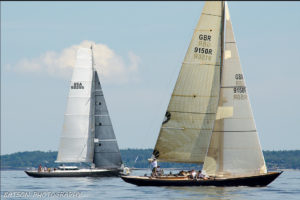
The modern-classic fleet was deep, featuring the most lovey “Isobel” and “Hoi An.” Photo: Andrew Batson
Regardless, the Spirit-of-Tradition class was thick with competitive boats, including our newest design to hit the racecourse—the 65-foot Anna, which saw her first racing. She took the bullet in Race 1, in a breezy fog-fest that left all aboard guessing the results — or seeing another boat, for that matter.
The second race was much lighter, but no less foggy. The thick clouds concealed large wind holes, which Anna promptly fell into, ending her chance at a two-race sweep. She held on to finish middle-of-the-pack in that race, giving her enough points to achieve a second-place, silver plate for the regatta. Not bad.
For the record, the Spirit-of-Tradition trophy went to Burt Keenan’s CH31 Mystery, making it three years in a row for this well-sailed yacht. Good for you, Burt!
See the full results here. And awesome race gallery here.
The Castine To Camden To Eggemoggin Reach Series: August 2-4
These races, part of the Wooden Boat Series held by the Camden Yacht Club, are only loosely linked into a circuit; they have no overall series score. But still, racers treat the events like a mini-Antigua race week. The series begins in Castine, where the Castine Yacht Club puts on a terrific dockside show and symposium celebrating some aspect of the classic yacht scene. This year it honored great Maine boat builders, and we were thrilled to have Anna representing Lyman Morse Boatbuilding at this event.
The real racing began on Thursday; with the Castine Classic Yacht Race, that is almost invariably a long beat against a building sea breeze down the east shore of Islesboro, followed by a short but exhilarating reach into Camden. This year was true to form: 35 boats competed, divided between classic and Spirit-of-Tradition boats, by about 80 to 20. All eyes were on Marilee, the newly restored NY40, out of the Belfast shop of French & Webb: This was her first race with her spiffy new Marconi sloop rig. And the long beat would be a good test. And sure enough, she drew a line in the sand with the rest of her fleet, finishing a full four minutes ahead of her nearest competitor, the S&S Sonny, on corrected time.
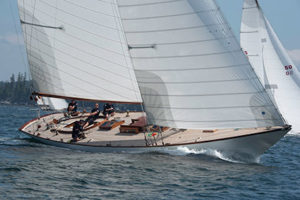
All eyes were on the NY-40 Marilee, built in 1926.
The building breeze made it a big-boat race. At the bottom mark, Anna saw true winds of a solid 20-plus knots. This pressure knocked the smaller, lighter boats around. And the unbalanced course of a fifteen-mile beat, followed by a reach of less than four miles rewarded boats for their windward prowess. And was especially unfair for these smaller boats, and for boats with longer, shallower keels. We struggled aboard Anna. Her size was a benefit, but her broad beam and shallow foils made it tough to keep up with the weatherly and well-sailed Blackfish, a 49-foot Jim Taylor design built by Brooklin Boat Yard.
Anna settled for second in Spirit-of-Tradition class, six minutes-plus behind Blackfish on corrected time. Isobel, the 68-foot speedster we designed in 2011, took third.
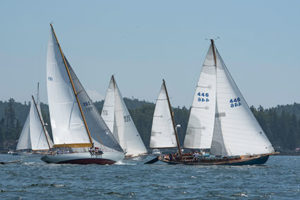
Stiff breezes and deep competition made for challenges for smaller boats.
Next, was the larger Camden Classic Yacht Regatta, usually known as the ‘Feeder Race’ to the Eggemoggin Reach Regatta that takes place on Saturday. It features a long, convoluted course, mostly reaching, from Camden through the congested waters of the Deer Isle Thorofare, then up Jericho Bay to Brooklin. It’s another unbalanced course, that perhaps pairs well with the previous day’s race. When the wind blows, thie course is a blast, with spectacular scenery flashing by under spinnaker. But when it doesn’t, the event is a drag. The wind didn’t blow this year, so the start was moved across Penobscot Bay; and we had a rollicking close reach to the top of North Haven under then Code Zero. We all then found a wind hole, and hit the brakes: Fifty-plus boats parked up and hunting for zephyrs. Pretty, though.
At one point, we had the bottom half of the boat on starboard tack, and the top half on port tack, as the fitful breaths of air spun off the high ground of Oak Island. Finally working out into East Penobscot Bay, we found a minefield of pot-buoys with a strong foul tide running with a light and variable breeze that we had to beat into. Very frustrating. We were glad when the finish was moved to the west end of the Thorofare, effectively cutting the course in half.
The smart sailors and weatherly boats did well, as did the lucky. We were neither smart nor lucky on Anna. We spent lots of time in soft breeze near the Deer Isle shore while watching boats on the right make big gains. Let’s just say we weren’t dead last in class—there was one boat beneath us.
Finally, there was the granddaddy of Maine classic racing events: the Eggemoggin Reach Regatta. Since 1985, it has been an annual pilgrimage to Brooklin, Maine, where over a hundred boats crowd the start line, making it one of the largest (classic or otherwise) races in the United States. The fact that all these boats are simply gorgeous to look at — some well over one hundred years old — and they are sailing along Maine’s most beautiful coastline, make this race a must-see affair.
The five starts sent the smaller classes first, forcing the larger boats to move through the rest of the fleet. This race is as much about watching classic boats as it is racing in them. Trust us, when a boat like the Fife schooner Altair passes you, well … you just stop and watch for a minute.
Aboard Anna, we were in the final start, the Spirit-of-Tradition B class. That made us a big boat that had to find its way through the small. The pin was heavily favored, with good pressure to the right. And a dozen boats all looking for that good start, stacked up at the pin end. We got squeezed out the back as the other boats muscled in around us. But we were able to tack out of the dirty air, into a clean lane, within a few seconds after the gun.
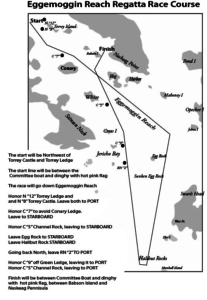
The lovely, and complex, course, offered challenging unbalanced legs.
Often this first leg out of Eggemoggin Reach is a skewed beat with long starboard tacks and short port boards, that work up the tight channel. But this year, the first beat was a single close reach, just slightly cracked off. The breeze built to 12 to 14 knots, as we exited into Jericho Bay, and by the time we rounded Egg Rock for the four-mile beat, it was blowing 17 or 18 knots true. That pressure powered us up on Anna, as we short-tacked the Swan’s Island shore. There was an accumulated seventy-plus years of experience in that race-course aboard Anna, which did not hurt. At the top of the beat, we got by Blackfish just as the fog closed in. And rounded the windward mark, Halibut Rock, to set our bigger asymmetrical downwind sail without incident.
A couple of jibes got us up and out of the bay, with the tide on our stern; then we hardened up for the jib-reach back toward the finish. The breeze backed as we closed on the line, so we went back to the asymmetrical for the final minutes and crossed the line at good speed, feeling like we had sailed a good race with few mistakes. Then we watched our clock, counting the seconds as Blackfish crossed: The finish was too close to call.
Later that night, we saw the final results over cocktails: Blackfish nipped us by TWO SECONDS for the win on corrected time. But what really gave us a thrill: the race was a victory for the new Classic Rating Formula, a system we had a hand in developing. It would be hard to find two more different boats between Blackfish and Anna. But even after a full afternoon of racing, to have a delta of just a few seconds is a good indicator of the rule’s effectiveness.
Our only wish might have been to have those two seconds go the other way.